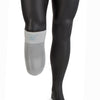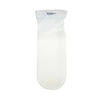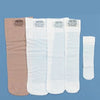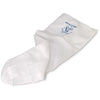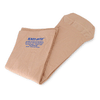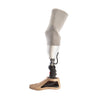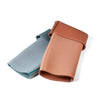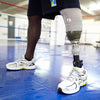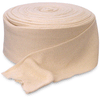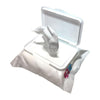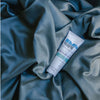Do I Have a Prosthetic Related Skin Disorder?
It could be abrasions caused by friction from perspiration build up. Maybe the pressure of the socket against the stump is damaging the skin and tissue, or maybe the socket is made of materials that are irritating your body. No matter how hard you try to prevent them, sores, abrasions, and other skin problems come with the territory when you wear a prosthesis every day.
What Causes Skin Disorders?
Many amputees are prone to excessive sweating -- they actually perspire more than the average. One reason for this is that amputees have smaller overall skin surface area, which makes the body's natural cooling mechanism less efficient. The higher than average levels of physical exertion required by wearing a prosthesis often causes amputees to sweat even more. And excessive sweating can be a problem for your skin.
Perspiration contains solids which accumulate in the socket of your artificial limb and on the residual limb. These solids, combined with the warm, moist environment within the socket, make a perfect breeding ground for bacteria. And as perspiration builds up within a socket it can also lead to your limb moving around, which generally leads to skin chaffing and abrasions.
Antiperspirant products and sweat-control textiles like prosthetic sheaths and stump socks can help you to control sweat as much as possible. There's no way to totally eliminate perspiration, but a strict daily prosthetic hygiene routine goes a long way towards preventing the numerous skin issues that can develop as a result of the socket environment.
Another common cause of skin disorders is bacteria. It's everywhere, and only some of it causes infection under the right circumstances. The warm, moist environment of the socket is an ideal place for the harmful kind of bacteria to thrive.
Normally, your skin expels bacteria when moisture on its surface evaporates. That process is prevented within a closed socket, where drying can't occur. Your skin also naturally contains a negative charge which repels bacteria, but a constant coating of salty perspiration can lead the skin to develop a positive charge, causing it to attract more bacteria than it usually would. When the number of potentially infectious germs is beyond the skin's normal capacity, correct and regular skin hygiene becomes even more important.
Skin Disorders Affecting Amputees
Sometimes skin disorders do occur from either issues with perspiration or from bacteria in the socket. For your own comfort, it's important to recognize and deal with these problems fast, before minor problems become big ones.
The following are some common problems that you may experience:
- Rashes and Abrasions - The most common skin problems for amputees. They might occur intermittently or frequently, depending on your body, your interface, and your skin care routine.
- Edema - Swelling, red-brown coloring, and drying and roughening at the end of your limb are signs of edema. Mild edema is normal while you adjust to a new prosthesis, but if it continues for too long it can lead to serious complications. Although it can be prevented with gradual compression with an elastic bandage or stump shrinker, you should always consult your doctor.
- Contact Dermatitis - An allergic reaction caused by an irritant. It could be caused by the socket material, or by a prosthetic cleanser, powder, lubricant, or some other product. Once you eliminate the cause of the reaction, the problem often goes away. In the meantime, thoroughly cleansing the skin and applying anti-itch lotions should offer some relief.
- Cysts - After a prosthesis has been worn for months or years, cysts may appear. They begin as small bumps, and they may vanish if the artificial limb is temporarily removed, but constant rubbing can make the problem worse as cysts become larger and more numerous. This is a common problem for above-knee amputees, especially on the inside of the leg along the upper edge of the prosthesis. Cysts should always be treated by a doctor before they become infected.
- Folliculitis - A bacterial infection of the hair follicle which, if left untreated, may later develop into painful boils. They begin with small, itchy areas and develop into deep-red nodules on the surface of the skin. Anti-bacterial soaps may not reduce the bacteria which cause this condition. Experienced amputees also recommend not shaving.
- Fungal Infections - A result of the moist, warm conditions inside your socket. These can be easily treated with special creams or powders.
- Eczema - Dry, scaly skin which becomes moist for no discernable reason, often caused by an allergy. Sometimes a secondary condition following edema. Eczema tends to recur until the cause is discovered.
- Adherent scars - Repeated infection or ulceration damage can cause scar formation so intense that scar tissue may attach to the underlying layers of skin. Surgery may be necessary to free the scar.
- Ulcers - Sores resulting from bacterial infections or from circulation problems. They may become chronic if they aren't diagnosed and treated immediately.
If you see signs of a developing skin disorder, take care of it as soon as possible. Letting a small problem linger may result in a period of time during which you can't wear your prosthesis while you wait to heal, which may lead you to miss out on work or other activities. The condition may be treatable with an over the counter remedy, or it may be best to see a doctor.
Related Articles:
- Alcohol & Skin Care: The Facts
- How-to create a prosthetic skin care routine?
- How do amputees deal with friction?
- How Does Your Skin Work?
- Ingredients To Avoid
- Know Your Skin Type
- Parabens: Are they really a problem?
- The DOs and DON'Ts of Skin Care
- Why are fragrance free products best?
- Why do some skincare products cause a negative reaction?
- Your Residual Limb Deserves Some TLC
- 15 Skin Problems Amputees Experience & How to Solve Them
- Common Skin Issues for Above-Knee Amputees














































